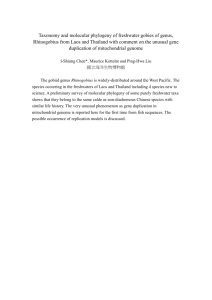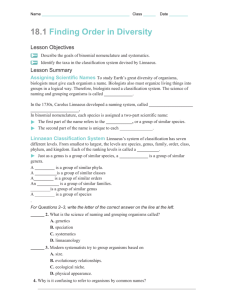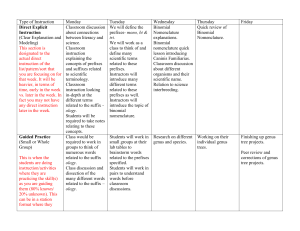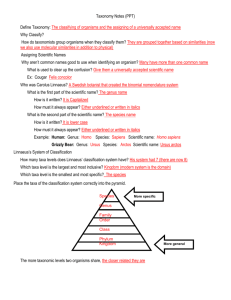Note on Systematics from September 8th
advertisement
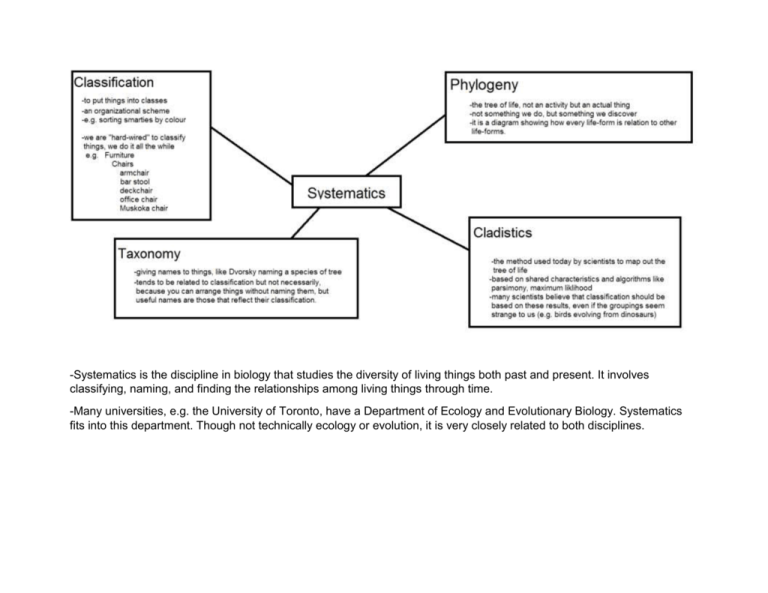
-Systematics is the discipline in biology that studies the diversity of living things both past and present. It involves classifying, naming, and finding the relationships among living things through time. -Many universities, e.g. the University of Toronto, have a Department of Ecology and Evolutionary Biology. Systematics fits into this department. Though not technically ecology or evolution, it is very closely related to both disciplines. Taxonomy In the previous class we looked at Taxonomy, naming things. Recap: Before talking about naming a species, you must decide on what a species is. The idea of species is just a concept. It is an idea we impose on nature for our convenience and utility. The biological species concept is perhaps the most common, it defines a species as a group organisms that can actually or potentially interbreed and produce fertile offspring. It does have problems however. What is to be done with asexual organisms? What to do with species that can hybridize with each other? [Ligers and Tigons cannot reproduce, but for example many hybrids of plants can]. -also, what is meant by potentially interbreeding? If a population of frogs were divided by a freeway, as shown below, that prevented the two groups of frogs from interbreeding, should we designate them as separate species? Probably not—but how distantly separated do they have to be before we draw the line? The morphological species concept seems simple enough, but appearance isn’t everything. For example, Western and Eastern meadowlarks look identical to each other but do not interbreed. Likewise ants in a colony may appear drastically different from each other because they have different roles but they are part of the same species. These two ants are both the same species and colony. The phylogenetic species concept envisions species as being the tips of phylogeny, that is to say the tips of the tree of life. It is the smallest set of organisms that share an ancestor and can be distinguished from other such sets. In the diagram above is the phylogeny of salamanders. Lineage A and B are separate species. Each shares a common ancestor that the other lineages do not. Lineage C is also a separate species. Even though there is some variation there, none of the variants in C has a common ancestor that separates it from other species. -there are believed to be over 26 different species concepts. As of today, 1.9 million species have been discovered and named. 4/5th of the species on Earth have yet to be discovered and named. -the right to name is given to the first scientific describer of the species. Not necessarily the first to discover it! –recall Dvorsky’s example, i.e. he named a species in the Florida Everglades without actually travelling there. -There are many regulations to be followed when naming a species, all of them fixed by the International Code of Zoological Nomenclature (ICZN) when animals are concerned, or the International Code of Botanical Nomenclature (ICBN) for plants.* Dvorsky attends every 4-5 years the Congress that makes changes to the ICBN. The next is 2017 in Shenzhen China. -In general, the nomenclature of creatures follows a system established 1758 by Linnaeus and each scientific species name is a composite of two parts, namely the genus name and the species name [binomial nomenclature]. For example, the scientific name of the European Common Frog is Rana temporaria, where Rana is the genus name and temporaria is the species name. As the genus name should reflect relationships among different species within the same genus, the first attempt after each discovery is to allocate the creature to a respective genus (and the systematic categories of higher hierarchical levels). Thus in most cases, with exception of the discovery of new genera, the genus name is fixed already, whereas the species name may be freely chosen by the scientific describer of the species within the frame of the ICZN or ICBN regulations. Some names are fun: Macrocarpaea apparata (a tall plant) was named after the magical spell "to apparate" from the Harry Potter novels by J. K. Rowling, as it seemed to appear out of nowhere. There is a wasp named Aleiodes gaga. There is a spider named Aptostichus barackobamai. There is a mite named Litarachna lopezae and a spider named Stasimopus mandelai and a wasp named Notiospathius johnlennoni. Classification -there is a rich history of those putting together a classification of living things. As mentioned above, as humans we put objects into classes without even realizing we are doing so. -the first major classification was performed by Carolus Linnaeus, 1700s in Sweden. -we are now at a crossroads due to modern technology: in 2009 the Angiosperm Phylogeny Group published a modern classification of flowering plants. Will your generation complete the tree of life? Linnaeus put together a hierarchical classification – species are arranged in categories from broad to narrow. Example of a hierarchical classification of musical instruments: The classification of musical instruments is said to be “nested” since the narrow categories can be arranged into broader ones. For example, the wind instruments are broken down into categories with valves and non-valves, with the conch shell, didjeridu, bugle, trombone, and animal horn being placed in the latter category. In the classification of organisms, the broadest rank or category is Domain. From there, the ranks get increasingly narrow (specific): Example: Killer Whales Domain: Eukarya (millions). Kingdom: Animalia (millions), Phylum: Chordata (tens of thousands), Class: Mammalia (thousands), Order: Cetacea (88), Family: Delphinidae (44), Genus: Orchinus (2), Species: orca (1)


